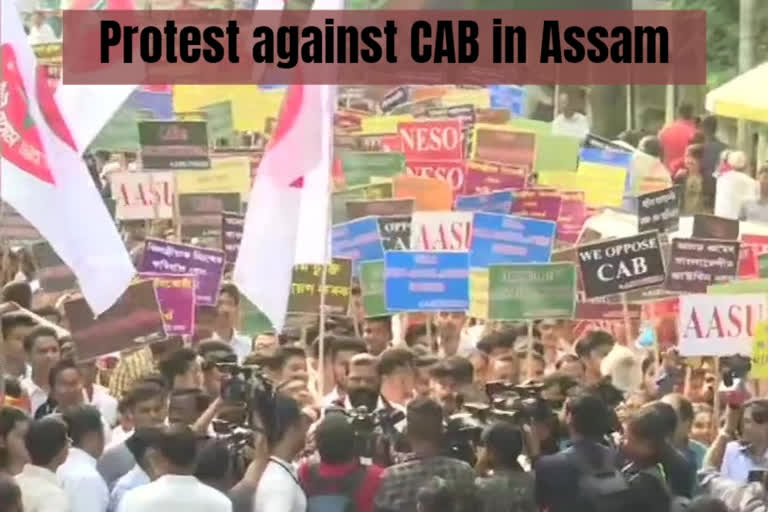New Delhi: With the ruling NDA government firmly set to push in the Citizenship Amendment Bill (CAB) in the ongoing session of Parliament that began Monday, the restive Northeast India region runs the risk of another impending disturbance, just as it was seeing some semblance of calm. Many organisations including students across the region have announced their vociferous opposition and have declared protest programmes.
At a time when most of the major armed insurgent organisations in Nagaland, Manipur, Assam, Meghalaya and Tripura are in negotiations with the government, the region, for some time now, has been a witness to an overall sense of calm.
With the government’s “Act East” focus finding resonance, of late there has also been an eager willingness among the people to be the harbinger of economic development through commerce by building up the historical and cultural ties with lands to the east of the Northeast.
“CAB is against the letter and spirit of the Indian Constitution because it differentiates on the basis of religion and doesn’t uphold our enshrined secular values. It is also a negation and turning back on the Assam Accord that was signed 34 years ago and yet is unimplemented,” says Mayur Bora, a leading Assamese social-political analyst.
“Fine, if you want to implement CAB, do it, but make special provisions for the Northeast, which has a very delicate demographic profile. Bulldozing CAB into Northeast has a lot of potential for unrest”, adds the author of several books.
What the CAB essentially proposes is to amend the Citizenship Act 1955. In the past, the Citizenship Act had been amended in 1986, 1992, 2003, 2005, and 2015. The bill seeks to grant Indian citizenship to people of six religions (Hindus, Sikhs, Buddhists, Jains, Parsis and Christians) from three countries (Afghanistan, Bangladesh and Pakistan) if they have been residing in India for at least 12 months immediately preceding the application for citizenship and for 6 of the 14 years preceding the 12-month period.
READ: Rajya Sabha marshals' uniform changes to military green
The reason behind CAB being opposed by the indigenous people of the region is because of the fear of a demographic change that may question the survivability of the indigenous.
“Long used to insurgency movements, the Northeast region has been relatively quiet, violence and unrest had ebbed. And then the government, without paying any heed to the genuine sentiments of the people, wants to push in the CAB. This will only create more problems,” says Bishwajit Sapam, a leading lawyer in Imphal.
“There is therefore, the urgent need for constitutional changes to guarantee political and economic security of the people,” he adds.
The Northeast, comprising seven states, is a rather strange entity. There are many things—ethnicity, cultural, behavioral, belief and value systems—that set it aside from the mainland.
With a distinct history that carved and shaped its own frontiers, be it the free-living ways of the Nagas and other tribes or the independent and powerful monarchies of the Assamese and the Manipuris, it stayed out of the pale of mainland history for long during the medieval ages.
Physically, the region is narrowly connected to the mainland by a 22-km-long wide land sliver often referred to as the “chicken’s neck”, the rest of its border is shared with Bhutan, China, Myanmar and Bangladesh. It was to protect the vulnerability of this narrow land strip from the high mountains to its north that Indian soldiers stood up to the Chinese for 73 days during the Doklam standoff in the summer of 2017. Anyone commanding those heights will easily control the 22-km corridor, a critical tactical issue with immense military significance.
While British rule eased their move to modern living, education and western traditions, it also nurtured a legacy of conflicts among the indigenous people of the region. In such a backdrop, therefore, many areas saw violent movements based on the concept of a separate identity. As a result, Assam, Manipur, Mizoram, Meghalaya, Nagaland and Tripura, have seen insurgency movements of which the Naga one is the world’s second-longest-running insurgency movement.
“The motivation behind the CAB is suspect and show lack of understanding of the sentiments of the Northeastern people,” says Temsula Ao, a writer, and ethnographer from Nagaland. “There is a threat it may cause unrest in the Northeast which was seeing some peace after ages,” she adds.
- Article by Sanjib Kr Baruah
READ: Stray dog tags along with Sabarimala pilgrims, treks 480 km and counting



